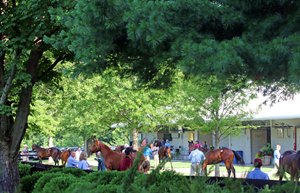Yearling Market Nears Finish Line


As the yearling auction season nears the finish line with two sales remaining, it appears that the year will end with modest declines in all major metrics, continuing the trends seen in recent years and earlier this year in the juvenile market.
According to data from BloodHorse MarketWatch, the cumulative gross of $359.5 million for the seven yearling sales to date represents a 5% decline from the same period a year ago. The 4,011 horses reported sold this year—only two more than in 2015 for the same number of auctions—have averaged $89,632, compared with $94,415 a year ago. The median has fallen from $42,000 to $35,000, a 16.7% decline.
In addition to the price declines, the percentage of horses bought back has spiked this year. Of the 5,651 offered during the seven auctions, 1,640 did not sell for an RNA rate of 29%. At this same time last year, 1,265—23.9% of 5,274 that had gone through the ring--had failed to attain their reserve prices.
As with the 2-year-olds in training sales, the market decline is driven by too many horses and not enough buyers. At the same time, a greater number of buyers are being more selective and willing to spend more on the future racing prospects they deem more desirable but bypassing those in the middle and lower price ranges.
The final two sales are both Fasig-Tipton venues: the Oct. 4 Midlantic sale in Timonium, Md., has cataloged 360 head, and 1,250 are entered in The October Sale Oct. 24-26 in Lexington.
Fasig-Tipton president and CEO Boyd Browning said he sees no reason to believe the outcomes of those two sales will be drastically different from the previous sales this year.
“I don’t know why we would have any expectation that it would be significantly different, either positive or negative,” Browning said.
Each of the upcoming auctions have their own niches within the marketplace, with the Midlantic sale serving regional breeders and buyers and the Kentucky sale providing the last opportunity to buy yearlings at auction.
“The Midlantic sale has traditionally been supported in a large part by breeders on the East Coast—Maryland, Virginia, and New York, with a sprinkling of horses from Kentucky and Florida,” the sales company executive said. “Obviously, there is some strong activity in that part of the country with Maryland having an improved (racing) program and continued interest in New York.
“There are an enormous number of trainers within a three-hour drive of Timonium that helps both the yearling and 2-year-olds in training sale there.”
Browning said the Kentucky auction has grown dramatically over the last five or six years. Not only is the last sale of the year, but it also serves a regional market.
“It gives someone an opportunity to buy horses that might have had an issue or been later maturing,” Browning said. “It’s one last shot for everybody. It also has become a quality place to a quality horse, a pretty good horse, or a horse that is an Ohio-bred, Indiana-bred, or Illinois-bred, supporting those states in proximity to Kentucky that have programs for state-bred races.”
